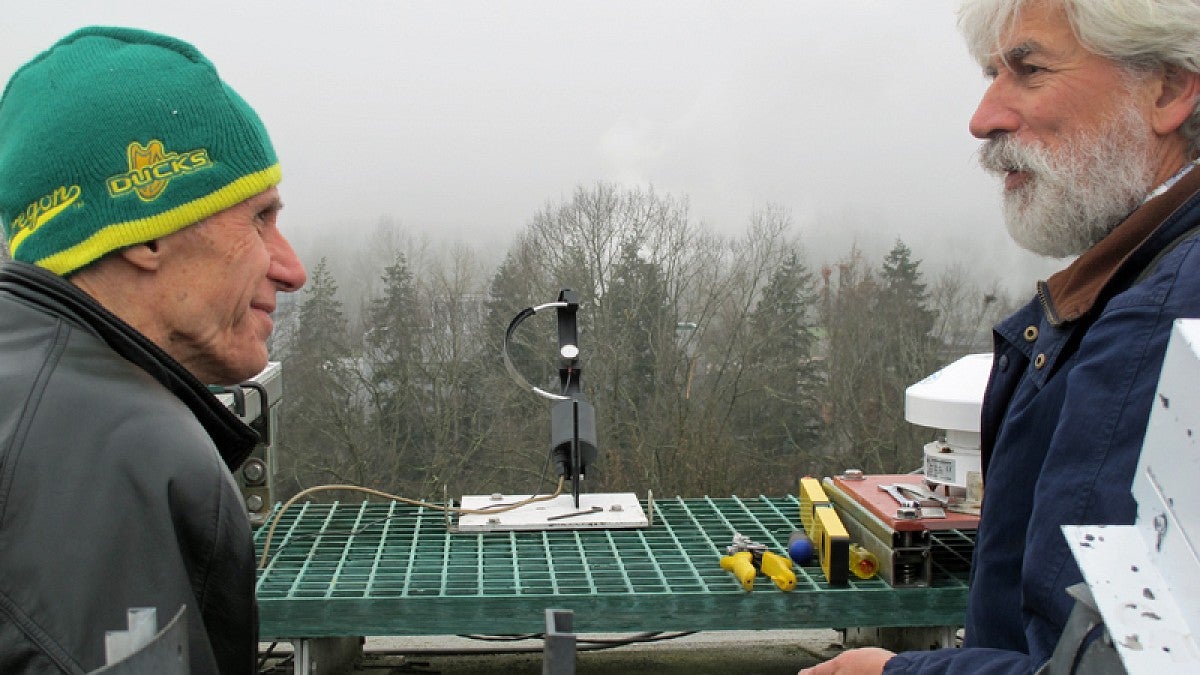It was cold and cloudy. Campus was still being cleaned up after a December ice storm. Nevertheless, atop Pacific Hall, a scientist from the United Arab Emirates installed a small breadbox-sized device to monitor solar radiation from the sun.
Oregon's winters have particular qualities that make this a good testbed for the prototype device, which measures the solar radiation that gets through the atmosphere to fall on things like photoelectric panels or mirrors. And the region's clouds and rain interfere with the sun's rays much the same way dust blots out the sun's radiation in the UAE, said Peter Armstrong of the Abu Dhabi-based Masdar Institute.
"In some countries there are a lot of aerosols in the air," said Frank Vignola, head of the UO's Solar Radiation Monitoring Laboratory. "Performance of solar power decreases with increasing aerosols. This new equipment is designed to more accurately determine the sunlight that can be captured."
Armstrong, a mechanical engineering professor, also has installed one at the Pacific Northwest National Laboratories, where he previously had worked for 15 years, in Richland, Washington. The two U.S. sites are among 10 locations around the world that will eventually deploy pilot versions of the device as Armstrong tests the technology before a commercial version is built.
The low-cost device — a Sunshape Profiling Irradiometer — scans the sky once a minute, gathering some 3,000 measurements in 12-second cycles to help calculate a profile of the total activity of sunlight coming from the sun and its outer regions.
That profile, Vignola said, includes the glow or halo around the sun. Solar energy coming from the halo region, especially when experiencing interference, needs to be removed from measurements to accurately evaluate the performance of concentrating solar systems. Those systems use mirrors to concentrate reflected sunlight and turn water into steam to drive turbine generators and can't use energy that is diffused by the atmosphere.
"Solar systems that concentrate sunlight to produce electricity can only utilize the solar energy coming directly from the solar disk," he said. "Because of the difficulty of aiming an instrument precisely at the solar disk all day long, instruments used to measure direct sunlight also measure sunlight in the vicinity of the sun."
Eventually, the more complete information that is gathered — not just how much, but what portions can and cannot be focused — about solar radiation hitting a particular area will be fed into new modeling systems.
The data also will improve estimates of electricity production and enable lending agencies to better assess the ability of a developer to pay back the loan. In turn, the data will help guide the construction of new energy-efficient buildings or systems that make use of solar power.
"In Abu Dhabi, there is almost constant dust in the air, giving the sky a yellowish tinge instead of blue," Armstrong said. "Solar-powered plants there and in Morocco are performing below expectations because they were built without sufficient data. You spend to build based on projections, and when you end up off by 10 percent you want to know why."
Armstrong approached Vignola about installing a test version of the device, which earned a U.S. patent in 2015, when they were attending a solar conference in South Africa. The UO's Solar Radiation Monitoring Laboratory has been collecting sunlight-related data in the Pacific Northwest since 1975. The web-available data the lab collects are made available to help in the planning, design, deployment and operation of solar-based facilities.
"Oregon is different than a lot of other climates," Armstrong said. "You have everything from full overcast to crisp and clear. The new device will monitor the region around the sun, even when the sun is almost invisible."
The UO's icy and rainy weather presented a challenge during installation. The device initially struggled to complete its scanning cycles.
"We hadn’t placed any of these devices in such a rainy area yet," said Armstrong, who has worked for 40 years on projects related to solar energy.
—By Jim Barlow, University Communications


